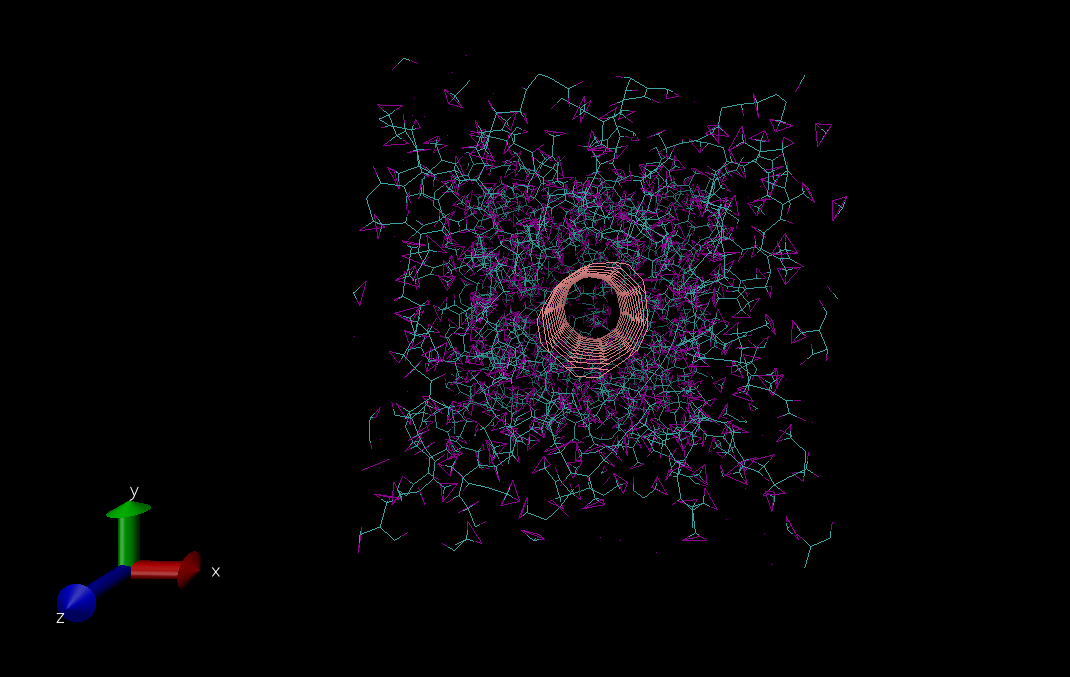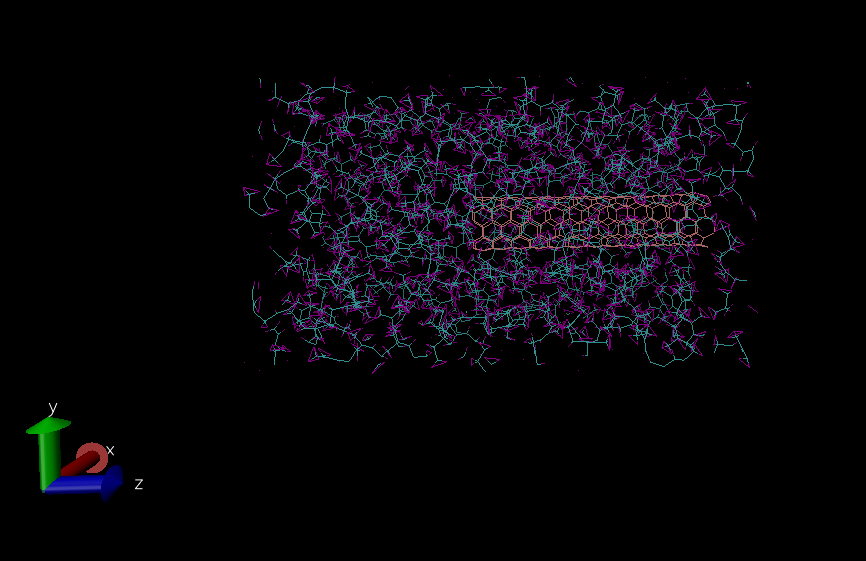dear lammps user
i’m trying to simulate a process of pulling out a single-wall carbon nanotube(cnt) from nature rubber(NR), see the model below ,the box is 303050 and during the simulation, i set velocity for 20 C atoms at the end of CNT and let it go along z-axis, but the whole CNT just don’t move , is there something wrong with my code ?
i’m so sorry if my question was stupid ,i’m new in lammps .
#3D Pull-out Simulation of Carbon nanotube and NR Matrix
units metal
dimension 3
boundary p p s
atom_style atomic
read_data data.heatup
neighbor 2.0 bin
neigh_modify every 1 delay 0 check yes
pair_style hybrid airebo 2.0 tersoff lj/cut 10.0
pair_coeff * * airebo CH.airebo C NULL H
pair_coeff * * tersoff SiC.tersoff NULL C NULL
pair_coeff 1 2 lj/cut 0.0047779 3.65 #CY Wei
pair_coeff 2 3 lj/cut 0.0 0.0
#pair_style airebo 3.0 1 1
#pair_coeff * * CH.airebo C C H
group cnt type 2
group nr type 1 3
region fixedb1 block INF INF INF INF INF 5 units box
group fixedb1 region fixedb1
region fixedbb2 block INF INF INF INF 5 INF units box
group fixedbb2 region fixedbb2
group fixedb2 intersect nr fixedbb2
group fixedb union fixedb1 fixedb2
group nrrest subtract nr fixedb
group cntend id 241:260
group cntrest subtract cnt cntend
group rest subtract all fixedb
#计算
#CNT受力
compute xf cnt reduce sum fx
compute yf cnt reduce sum fy
compute zf cnt reduce sum fz
#温度
#总体温度
compute Tempcntall cnt temp
compute Tempcnt cntrest temp
compute Tempnr nrrest temp
#总体温度分布,不考虑质心运动
compute Tempran all temp/profile 1 1 1 xyz 1 10 10 out bin
compute_modify Tempran dynamic yes
#CNT分环温度
group cnt1 id 1:20
group cnt2 id 21:40
group cnt3 id 41:60
group cnt4 id 61:80
group cnt5 id 81:100
group cnt6 id 101:120
group cnt7 id 121:140
group cnt8 id 141:160
group cnt9 id 161:180
group cnt10 id 181:200
group cnt11 id 201:220
group cnt12 id 221:240
group cnt13 id 241:260
compute Tempnr1 cnt1 temp
compute Tempnr2 cnt2 temp
compute Tempnr3 cnt3 temp
compute Tempnr4 cnt4 temp
compute Tempnr5 cnt5 temp
compute Tempnr6 cnt6 temp
compute Tempnr7 cnt7 temp
compute Tempnr8 cnt8 temp
compute Tempnr9 cnt9 temp
compute Tempnr10 cnt10 temp
compute Tempnr11 cnt11 temp
compute Tempnr12 cnt12 temp
compute Tempnr13 cnt13 temp
#环状温度分布
region cnth cylinder z 15 15 7.5 20.0 INF units box
compute Tempcnth cnt temp/region cnth
region nrh cylinder z 15 15 7.0 20.0 INF units box side out
compute Tempnrh nrrest temp/region nrh
region nr01in cylinder z 15 15 10.0 20.0 INF units box
region nr01 intersect 2 nrh nr01in
compute Tempnr01 nrrest temp/region nr01
region nr01out cylinder z 15 15 10.0 20.0 INF units box side out
region nr02in cylinder z 15 15 12.5 20.0 INF units box
region nr02 intersect 2 nr01out nr02in
compute Tempnr02 nrrest temp/region nr02
region nr02out cylinder z 15 15 12.5 20.0 INF units box side out
region nr03in cylinder z 15 15 15.0 20.0 INF units box
region nr03 intersect 2 nr02out nr03in
compute Tempnr03 nrrest temp/region nr03
region nr03out cylinder z 15 15 15.0 20 INF units box side out
region nr04in cylinder z 15 15 17.5 20 INF units box
region nr04 intersect 2 nr03out nr04in
compute Tempnr04 nrrest temp/region nr04
region nr04out cylinder z 15 15 17.5 20 INF units box side out
region nr05in cylinder z 15 15 20.0 20 INF units box
region nr05 intersect 2 nr04out nr05in
compute Tempnr05 nrrest temp/region nr05
region nr05out cylinder z 15 15 20.0 20 INF units box side out
region nr06in cylinder z 15 15 22.5 20 INF units box
region nr06 intersect 2 nr05out nr06in
compute Tempnr06 nrrest temp/region nr06
region nr06out cylinder z 15 15 22.5 20 INF units box side out
region nr07in cylinder z 15 15 25.0 20 INF units box
region nr07 intersect 2 nr06out nr07in
compute Tempnr07 nrrest temp/region nr07
region nr07out cylinder z 15 15 25.0 20 INF units box side out
region nr08in cylinder z 15 15 27.5 20 INF units box
region nr08 intersect 2 nr07out nr08in
compute Tempnr08 nrrest temp/region nr08
region nr08out cylinder z 15 15 27.5 20 INF units box side out
region nr09in cylinder z 15 15 30.0 20 INF units box
region nr09 intersect 2 nr08out nr09in
compute Tempnr09 nrrest temp/region nr09
timestep 0.0001 #时间步长0.0001 ps,即0.1 fs
#能量最小化
min_style sd
minimize 1.0e-10 1.0e-10 100000 100000
reset_timestep 0
#拉出碳纳米管
velocity fixedb set 0 0 0
fix FIXEDB fixedb setforce 0 0 0
fix NVE all nve
velocity cntend set 0.0 0.0 0.3 sum yes units box #CNT往z+方向移动0.3A/ps,30m/s,108km/h
thermo 5000
thermo_style custom step temp press pe ke evdwl vol density c_xf c_yf c_zf c_Tempcntall c_Tempcnt c_Tempnr
fix Temp_cnt all ave/time 10000 1 10000 c_Tempnr1 c_Tempnr2 c_Tempnr3 c_Tempnr4 c_Tempnr5 c_Tempnr6 c_Tempnr7 c_Tempnr8 c_Tempnr9 c_Tempnr10 c_Tempnr11 c_Tempnr12 c_Tempnr13 file temperature_cnt_zbin.profile
fix Temp_all_cylinder all ave/time 10000 1 10000 c_Tempnr01 c_Tempnr02 c_Tempnr03 c_Tempnr04 c_Tempnr05 c_Tempnr06 c_Tempnr07 c_Tempnr08 c_Tempnr09 file temperature_all_cylinder.profile
fix Temp_all_yzbin all ave/time 10000 1 10000 c_Tempran file temperature_all_yzbin.profile
dump trj all atom 5000 la.lammpstrj
run 1100000 #

